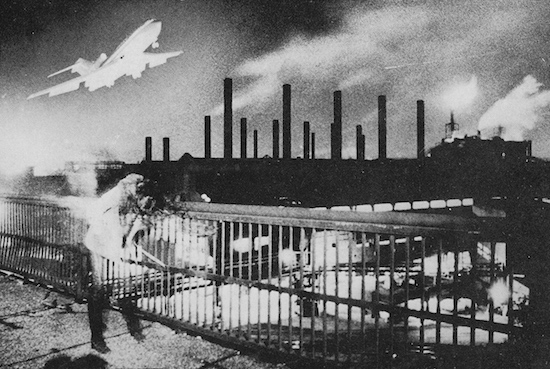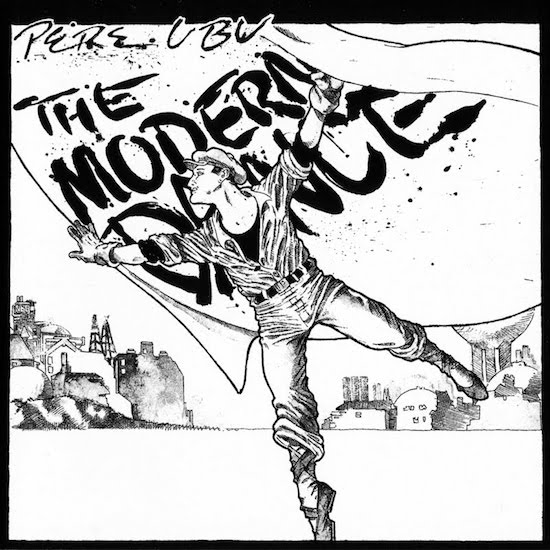In a December 1975 interview with Jane Scott of The Plain Dealer, a heavyset, wild-haired Cleveland singer known as Crocus Behemoth declared, "We’re putting out the hits of the next psychedelic era. If a melody fits in, fine. If not, we don’t feel we have to use one. We’re a bit ahead of our time, but that’s the fun of it.”
Mr. Behemoth was referring to his new band, Pere Ubu. Although they were yet to play their first show, they were already a familiar proposition in the nascent Midwest punk scene. Three months earlier, Cleveland proto-punk heroes Rocket From the Tombs self-imploded, leaving behind a trail of half-finished songs and tales of self-destruction and farce-filled gigs. Of its classic line-up – which Lester Bangs once called “the original legendary underground rock band” – Gene O’Connor and Johnny Madansky formed Frankenstein, before settling on the name The Dead Boys. Meanwhile, the shrieking Crocus Behemoth, otherwise known as David Thomas, reunited with RFTT founding guitarist and livewire Peter Laughner, before recruiting second guitarist Tom Herman, bassist Tim Wright, drummer Scott Krauss and synthesist Allen Ravenstine. Pere Ubu was born.
As Thomas and co. went about cutting their teeth – playing their first show, rather poetically, back-to-back with Frankenstein on New Year’s Eve 1975 – Cleveland was a city in steady decline. Many steel factories and manufacturing hubs were folding, environmental studies were warning that the Cuyahoga River was dead and Lake Erie was dying, and by 1978, it would become the first U.S. city since the Great Depression to default on its financial obligations. Throughout the decade, Cleveland would lose a staggering 23.6 percent of its population. But much like NYC, rock n’ roll’s psychic cul-de-sac par excellence, this milieu of escalating urban downturn would play muse to the stark explorations of Pere Ubu’s first singles. From the oppressive avant-doom of re-worked RFTT song ‘30 Seconds Over Tokyo’ to the fist-clenched ‘Final Solution’, they filtered Rust Belt desolation and Cold War jitters like no other. Even so early on, Ubu’s self-described “industrial folk” already sounded like it came from some far-off, future land.
Bar a handful of dates at Max’s Kansas City in NYC, Pere Ubu were a regular fixture in Cleveland clubs such as Pirate’s Cove and The Mistake throughout throughout 1976 and 1977. Having left the band after the release of their first two singles (David Thomas later told Penny Black magazine, "It was obvious he was a dead man walking and we didn’t want to be part of the process") the death of Peter Laughner from chronic pancreatitis in June 1977 re-aligned the band’s trajectory towards a realm that resembled Rocket From The Tombs less and less by the week. In England’s Dreaming, Jon Savage noted how "Laughner’s death marked a change in direction from ‘the destructive illusions essential to certain popular rock and art aesthetics’ to a disciplined, pragmatic optimism." With new bassist Tony Maimone replacing Tim Wright for their second iteration, Pere Ubu took to Cleveland’s Suma Studio in November 1977 to record The Modern Dance.
When it split off from Cleveland Recording in 1976, Ken Hamann’s Suma Studio relocated to the woods of Cleveland’s Lake County. Although they weren’t familiar with the space, Pere Ubu were on professional terms with producer Ken Hamann, who had recorded ‘Street Waves’ w/ ‘My Dark Ages (I Don’t Get Around)’ and ‘The Modern Dance’ w/ ‘Heaven’ in late 1976 and early 1977. It was a match that seemed to work: recording on a 2 inch 24 track Ampex MM-1200 via a 48 channel dual board (“so that one can mix at the same time as recording” Hamann later noted in a Tape Op interview) they worked fast. With all the instruments situated in the same room, at the same time, Hamann said, “Most of the recordings were done with the basic tracks first, embellishments second – that is guitar things and so forth – and then the vocals last." Having been in the game for four decades, Hamann understood Ubu’s forward-thinking modus operandi. Mixing as he went, the veteran engineer recorded, produced and finalised The Modern Dance in just two weeks.
Financed by Mercury Records through Blank Records – an imprint founded ad hoc for Ubu – The Modern Dance was released in January 1978 amidst one of the most significant turning points in modern music. With the golden age of New Wave just around the corner, Pere Ubu’s feature-length gambit – unveiled alongside Wire’s Chairs Missing, Adventure by Television and Q: Are We Not Men? A: We Are Devo! by fellow Ohioans Devo – marked the advent of what would soon, largely thanks to the staff at Sounds, be widely known as post punk. Informing the world that the new avant-garde revolution would not be coming from New York, but Cleveland, it was a record that, perhaps more than all of the genre-warping masterstrokes to be released in 1978, was a conscious rejection of the heady, wilful artlessness of punk rock. Though he wasn’t around to see it come to pass, when Peter Laughner told Jane Scott of The Plain Dealer back in December 1975, “We’re pointing toward the music of the ’80s” he wasn’t kidding. Blurring the lines between avant-garde surrealism, Beefheart, futurist minimal rock, Velvet Underground and an abundance of dark humour, the relentlessly experimental, genre-blending glory of The Modern Dance subverted the DNA of punk as it was taking over the world.

The Modern Dance, vinyl photo. Photo by Mik Mellen.
Having later told the Guardian “the bass player is actually the band’s guitarist, the guitarist is the bassist, the synthesiser is the vocal and I’m the horn section” David Thomas headed a formation on The Modern Dance who instinctively embodied the “post” spirit long before it came to demarcate music at the turn of the 1980s. From Allen Ravenstine’s ear-splitting intro to the mutated Chuck Berry boogie of ‘Non-Alignment Pact’, Thomas and co. bound forth with a erratic message of confusion and ecstacy. By the time the experimental shimmy and ominous musique concrete of ‘The Modern Dance’ masterfully unravels, Pere Ubu have already woven an outlandish patchwork of anxiety, art, glory, sex and death.
On the proto-New Wave strut of ‘Street Waves’, Allen Ravenstine’s synth swells conjure the frequencies of chemical fallout. Working like a dub producer, Ravenstine didn’t as much play his EML 101 and 200 analog synthesizers than manipulate them, coaxing out whooshes, warped swells and eerie radio static via knobs, switches and various patches. As well as performing tape manipulation and saxophone throughout, his minimalist, non-traditional approach to playing keyboards is a vital feature of the aesthetic singularity of The Modern Dance. And where the bass-led bob and open-ended doom-jazz of ‘Laughing’ sounds like Murmur fed through the recesses of Don Van Vliet’s mind, Pere Ubu’s vagrant experimentalism peaks on ‘Chinese Radiation’, a track that, as well as predating Sonic Youth, Pavement and every other 1990s U.S. indie rock band by a generation, remains a parameter-stretching high point of experimental rock n’ roll.
Whereas Side One struts, Side Two is a neurotic shuffle. The sole track on the album credited to Peter Laughner, ‘Life Stinks’ is a squawking, Dadaist deluge of Thomas’ vocals and musette and Ravenstine’s sax. Here – as with much of The Modern Dance – one can trace the stylistic birth of Peter Hook and the sub-funk of Jah Wobble in Tony Maimone’s disjointed, dominant bass-lines. Evoking images of David Thomas spouting gibberish on some solitary, psychotic walk home from a Rust Belt rock & roll show, the smashed glass and winding darkness of ‘Sentimental Journey’ preempts the doomy lonerism of Jandek, Slint’s ‘Don, Aman’ and more, while ‘Over My Head’ remains one of the era’s most perfectly abstracted, slow-burning love-songs, a track straddling the thin line between demented and gushing like few others. The Modern Dance flames out on ‘Humor Me’, the sound of one last shimmy before the bomb drops at dawn.
But for all its masterful musicianship, it’s David Thomas that effortlessly sets The Modern Dance apart. Equal parts presence and performance, he is a bag of bad nerves from beginning to end; the twitching, burly man you really hope doesn’t sit beside you on the bus ride home. With Hamann having said his vocals were recorded "carefully, sometimes phrase by phrase, which is still the case" his nervy, rambling psycho-babble is – though certainly in the same vein of Tom Verlaine and David Byrne – of its very own spooky, at times brilliantly manic caste. No frontperson came close to invoking the dark cloud that hung over the industrial midwest throughout the 1970s as Thomas does on The Modern Dance and its follow-up, Dub Housing.
Having built up a steady following in the UK, Pere Ubu played their first non-U.S. show at Rafters nightclub in Manchester on April 28, 1978. Having acquired an advance copy of The Modern Dance via import two months earlier, Jon Savage was in attendance. He recalls seeing members of the newly-named Joy Division in attendance. "Peter Hook was definitely there,” he says. "He was the most visible member then. I seem to remember it was busy. There was plenty of interest – Geoff Travis covered it for Sounds and I had already reviewed the album.” With Unknown Pleasures a whole seventeen months away, it would have been patent to many in attendance that night that Pere Ubu foreshadowed what post-punk would soon manifest itself as before Gang of Four, Cabaret Voltaire, Magazine, PiL et al. followed suit later in the year.
Having told Search And Destroy in 1977 that he considered Pere Ubu “to be a pop band, totally the same as Wings, or The Music Explosion or The Archies. It’s just that we are doing more modern and therefore better pop music”, David Thomas has since seemed content with “avant-garage”. But as much pop as they were avant garde and, in many ways, anti-punk, Pere Ubu excavated the ruins of rock & roll and refashioned it – as foretold by Crocus Behemoth back in 1975 – as a sort of strange new psychedelia. Though their debut album sold poorly, they offered up an alternative to self-destruction and wallowing within the confines of downturn. On The Modern Dance, Pere Ubu’s performance was not a self-pitying death march but first-rate doom boogie. Rock, pop and punk – whichever subset you prefer – has struggled to find a more compelling soundtrack to alienation, madness and pure joy since.


